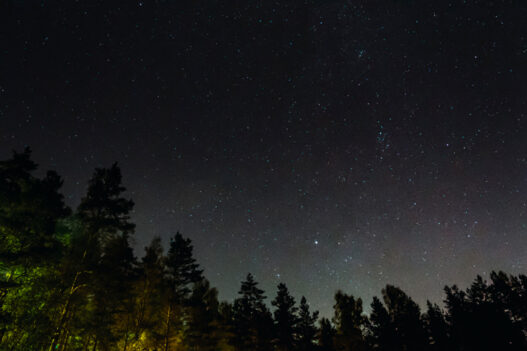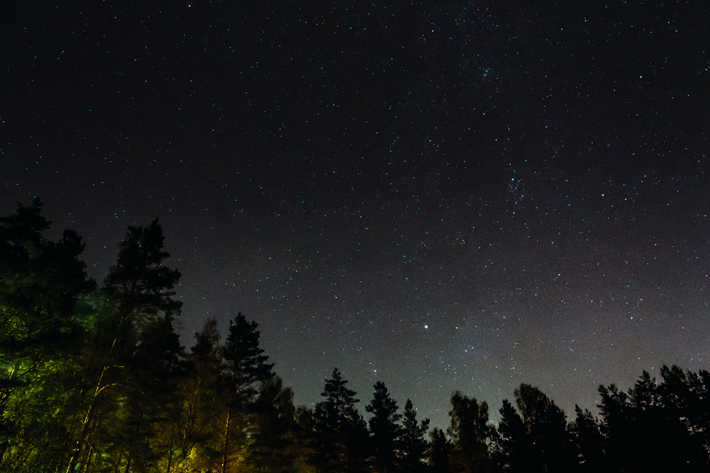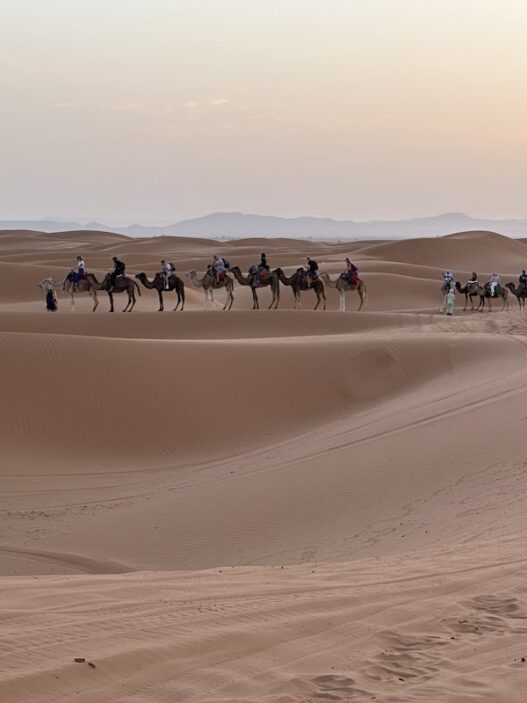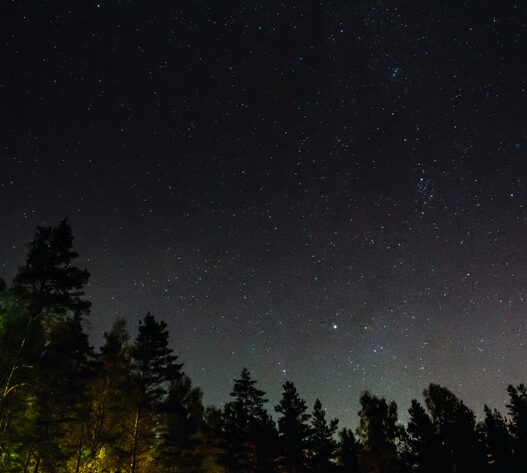Ever looked up at the night sky and felt like you could see the entire universe?
That's what it felt like during one of my road trips through the Southwest.
I visited in January, when the air was cool, the crowds were low, and the stars felt even sharper against the crisp night sky. If you've only explored the East Coast before, this side of the country will completely change your perspective – instead of lighthouses and seaside drives, you'll find red-rock canyons, desert campgrounds, and endless sky.
Camping out here is pure freedom – you wake up to golden desert sunrises, spend your day hiking through surreal rock formations, and fall asleep under constellations so clear they almost don't look real. If you love finding unique stays like off-grid cabins or desert domes, the Southwest has some of the most unforgettable ones I've come across.
Planning a road trip here is easier than you'd think. I used my eSIM to stay connected through remote highways where regular SIMs lose signal – a lifesaver for checking weather, mapping routes, or finding the next gas stop.
The Southwest isn't just about adventure – it's about slowing down, camping under a blanket of stars, and remembering how vast the world really is.
7 Best Campgrounds For Stargazing In The Southwest
Nuuksio National Park
If you're ready to plan your trip, you're in luck. The Southwest is home to incredible stargazing camping spots, each offering its own mix of scenery, accessibility and unforgettable night skies.
1. KOA Campgrounds
If you're new to camping in the American Southwest, or simply love the idea of sleeping under a blanket of stars without giving up comfort – KOA Campgrounds are a great place to start.
I stayed at several during my last Southwest road trip, hopping between red-rock deserts, mountain passes, and wide-open plains — and honestly, KOAs were the perfect mix of convenience meets cosmos.
Most KOA campgrounds are located close to national parks, scenic byways, and certified dark-sky reserves, giving you easy access to some of the best stargazing spots in the US. You can spend the day hiking through sandstone arches or slot canyons, and come back to your campsite to watch the Milky Way stretch across the desert sky.
Here are some top picks across the region worth adding to your map:
- Moab KOA Holiday in Utah
- Richfield KOA Holiday in Utah
- Montrose / Black Canyon Nat'l Park KOA Journey in Colorado
- Williams / Exit 167 / Circle Pines KOA Holiday in Arizona
- Grand Canyon KOA Journey in Arizona
- Alamogordo / White Sands KOA Journey in New Mexico
KOA balances accessibility and the chance to see stars. Families can enjoy daytime activities like hiking or swimming, then settle in under wide-open skies once the sun dips below the horizon.
Unlike more remote campsites that require long drives or tricky access, KOAs tend to be close to major routes but still far enough from urban glare to give you a clear shot at the Milky Way.
Key Features
- Convenient access to highways while still close to dark-sky areas
- Options ranging from tent sites to cabins and RV hookups
- Family-friendly amenities like pools, playgrounds and picnic areas
- Many locations near national parks renowned for stargazing, including the Grand Canyon, Arches and Zion
- On-site camp stores for last-minute supplies and firewood
2. Chaco Canyon Campground, New Mexico
Long before telescopes or apps existed, the Ancestral Chacoans built their great houses here aligned with celestial events – proof that this desert canyon has always been a place for sky-watchers.
What makes this site extra special is the connection between sky and history.
Walking among the ruins during the day, you'll notice how ancient walls and doorways line up perfectly with solar and lunar cycles — a reminder that the Chacoans studied the stars to shape their architecture and rituals. At night, you're gazing at the same skies they once charted thousands of years ago.
If you're lucky, you might join one of the ranger-led stargazing programs, where experts set up telescopes and explain the park's cosmic stories. It's both educational and deeply grounding — a blend of science and spirituality that captures what slow, meaningful travel should feel like.
Key Features
- Located in a certified International Dark Sky Park
- Stunning views of the Milky Way and planets
- Night-sky ranger programs and guided stargazing events
- Primitive camping with limited amenities for a more authentic experience
- Ancient Chacoan ruins nearby for cultural and historical context
Because of its remote location, Chaco Canyon is best visited as part of a Southwest national parks road trip, you can easily connect it with places like Mesa Verde in Colorado, Canyon de Chelly in Arizona, or even White Sands National Park further south.
Download your Google Maps offline route so you don't lose navigation in this desert stretch.
If you've ever dreamt of combining archaeology, astronomy, and adventure, Chaco Canyon offers all three – and under one of the darkest skies in North America.
3. Big Bend National Park, Texas
Trailer
There's a lot of must-do things in Dallas, Texas. If you want to experience true wilderness paired with one of the best places for stargazing, Big Bend is a must.
The Chisos Basin Campground sits surrounded by dramatic mountains, giving you a sense of seclusion and peace that's hard to find elsewhere. The sky explodes with stars at night, and Big Bend is recognised as one of the darkest parks in the U.S.
Beyond the clarity of the stars, the park offers a range of terrain to explore during the day, from desert trails to canyons carved by the Rio Grande. It's also a popular location for astrophotography, as the landscape makes a breathtaking backdrop to the night sky. This mix of rugged adventure and cosmic beauty makes it a bucket list destination for campers.
Key Features
- Located in one of the darkest national parks in the U.S.
- Spectacular mountainous backdrop for astrophotography
- Campsites available for tents and small RVs
- Extensive hiking trails and scenic drives in the area
- Frequent ranger-led stargazing programs and events
4. Bryce Canyon National Park, Utah
Bryce Canyon is famous for its unique hoodoo formations, but it's also one of the top stargazing camping spots in the Southwest.
The North Campground gives you easy access to daytime hiking among the red rock spires and nighttime skies filled with stars. Thanks to the park's high elevation and clean air, the visibility here is truly remarkable.
Each summer, Bryce Canyon hosts an annual Astronomy Festival, drawing skywatchers from around the world. Even if you can't make the festival, the campground is a perfect spot for setting up your own telescope or simply lying back and watching the shooting stars. The combination of stunning landscapes and pristine skies makes Bryce an unforgettable stargazing location.
Key Features
- High elevation and clean air ideal for stargazing
- Annual Astronomy Festival with guest speakers and telescope viewings
- Convenient access to hiking trails and viewpoints
- Tent and RV sites available with modern amenities
- Hoodoo formations provide dramatic landscapes for photography
5. Joshua Tree National Park, California
Milky way stargazing!
Joshua Tree is one of the most iconic stargazing locations in the Southwest, and Jumbo Rocks Campground is right in the middle of it all. With giant boulders and wide-open desert skies, this site offers an otherworldly backdrop for your night under the stars. The dry desert air means clear skies most of the year, and because the campground sits away from urban areas, light pollution is minimal.
This spot is especially popular with astrophotographers. The dramatic silhouettes of Joshua trees and massive rock formations make for striking images against the Milky Way. By day, you can scramble over boulders or hike trails that showcase the desert's unique beauty, then cap the evening off with one of the most breathtaking celestial shows you'll ever witness.
Key Features
- Located in one of the most famous desert parks for stargazing
- Minimal light pollution with consistently clear desert skies
- Iconic Joshua trees and rock formations perfect for photography
- Over 120 campsites available, including tents and RVs
- Easy access to hiking trails and climbing routes within the park
6. Grand Canyon National Park, Arizona
Grand Canyon, Arizona
While most people visit the Grand Canyon for the views by day, it's also one of the best places for stargazing in the Southwest. Mather Campground, situated on the South Rim, offers easy access to the night skies that stretch endlessly above the canyon. At certain times of the year, the Milky Way is visible arching directly over the rim.
This campground offers more amenities than some remote backcountry sites, making it ideal for those who want convenience and starry skies. Ranger-led astronomy talks and telescope programs are often hosted here, which means you can enjoy expert insights into what you see above. Pair the canyon's sweeping vistas with the brilliant night sky, and you'll quickly understand why this is a top choice for stargazing camping.
Key Features
- Situated on the South Rim of the Grand Canyon
- Regular ranger-led astronomy programs and night-sky events
- Well-developed amenities such as restrooms, water and picnic tables
- Tent and RV sites available with shuttle bus access to the park
- Panoramic night views directly over the canyon
7. Canyonlands National Park, Utah
Canyonlands is an International Dark Sky Park, and the Island in the Sky Campground gives you front-row access to some of the clearest skies in the country. The elevated plateau offers uninterrupted views of the stars, planets and constellations. On a moonless night, the sheer number of visible stars is staggering, making this one of the most rewarding stargazing locations in the region.
Towering cliffs and canyons add a sense of depth to the night-sky experience, and by day, the views stretch for miles across rugged desert terrain. While amenities here are limited, the trade-off is unbeatable access to stargazing and hiking adventures without crowds.
Key Features
- Certified International Dark Sky Park with exceptional visibility
- Elevated plateau ideal for wide-open sky views
- Primitive camping for a more rugged experience
- Nearby overlooks perfect for sunrise, sunset and astrophotography
- Fewer crowds compared to more popular Utah parks like Arches and Zion
Tips for A Successful Stargazing Camping Trip
Finding the right stargazing locations is just the start. Making the most of your night under the stars requires the right gear and mindset to elevate the experience from memorable to extraordinary.
- Check the lunar calendar: Plan your trip during a new moon for the darkest skies and maximum star visibility.
- Dress in layers: Even desert regions can get surprisingly cold at night, so bring extra clothing to stay comfortable.
- Pack the right gear: Binoculars are beginner-friendly, while telescopes offer a closer look at planets and deep-sky objects.
- Bring comfort items: A reclining camp chair, blankets, cushions or a sleeping pad make long hours of stargazing much more enjoyable.
- Try astrophotography: Use a sturdy tripod and long exposure settings on your camera or phone for stunning sky captures.
- Plan for timing: Meteor showers, eclipses and other celestial events can make your trip even more unforgettable.
- Respect the land: Follow Leave No Trace principles to keep stargazing camping areas pristine for everyone.
Travelling through the American Southwest is a reminder that sometimes the best views aren't in front of you – they're above you. From the red-rock deserts of Utah to the quiet mesas of New Mexico, every campground here offers a different kind of magic once night falls.
Many of these stargazing sites sit close to national parks or scenic byways, making them easy to weave into an itinerary that blends day hikes, cultural landmarks, and quiet nights under the stars. Before heading out, export your Google Map itinerary and use it offline, especially when driving through long stretches with no signal.
No matter where you go, remember that the best kind of travel slows you down, widens your gaze, and makes you look up.



















